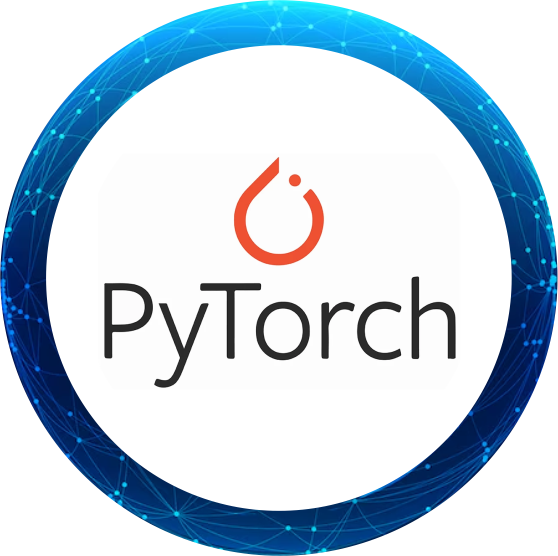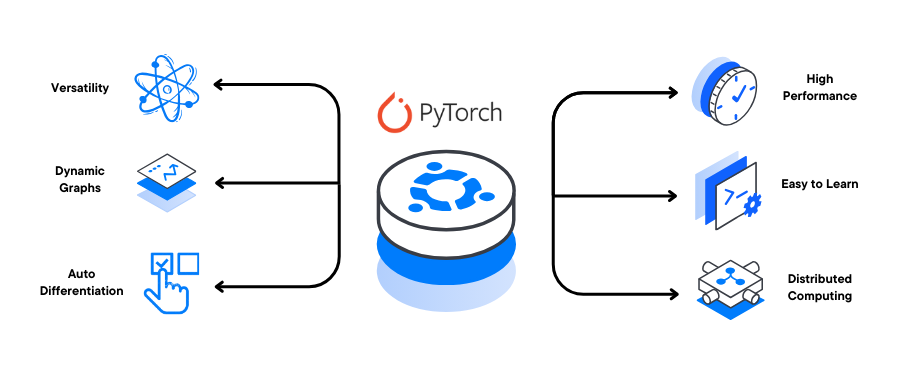PyTorch


in Data Science and AI
PyTorch is a leading deep learning framework known for its flexibility, ease of use, and dynamic computation graph.
It supports eager execution, making debugging and experimentation intuitive and Pythonic. PyTorch has become the de facto standard in academic research, especially for AI, ML, NLP, and vision tasks.
It powers production-ready systems with TorchScript, ONNX export, and mobile deployment capabilities.
PyTorch integrates seamlessly with Python libraries like NumPy, Pandas, and Scikit-learn for end-to-end ML workflows.
It supports automatic differentiation and GPU acceleration, making model training efficient and scalable.
PyTorch provides modular APIs—
torch.nn,torch.optim,torchvision,torchtext—to build any ML/DL system.It is used behind cutting-edge models like GPT, BERT, ResNet, YOLO, and in AI companies including Meta, OpenAI, and Tesla.
PyTorch’s open-source ecosystem and active community offer state-of-the-art models and reproducible research.
Learning PyTorch gives students strong foundations in building, training, and deploying AI models from scratch.

Module 1: Introduction to PyTorch
What is PyTorch?
PyTorch vs TensorFlow
Installing PyTorch (CPU/GPU)
Overview of key libraries:
torch,torch.nn,torchvision
Module 2: Tensors and Operations
Creating tensors: from lists, arrays, random values
Tensor properties: shape, dtype, device
Basic tensor operations: arithmetic, broadcasting
Indexing, slicing, reshaping
Converting between NumPy and Torch
Module 3: Automatic Differentiation with Autograd
Introduction to
torch.autogradComputing gradients with
.backward()Computational graph explanation
Using
requires_grad,detach()Chain rule and gradient flow in networks
Module 4: Building Neural Networks
Using
torch.nn.ModuleDefining
__init__andforward()methodsLayers:
Linear,ReLU,Sigmoid,SoftmaxModel parameters and initialization
Saving and loading models
Module 5: Training a Neural Network
The training loop:
Forward pass
Loss computation
Backward pass
Weight updates
Optimizers: SGD, Adam, RMSprop (
torch.optim)Loss functions: MSE, CrossEntropy, BCE
Evaluation metrics: accuracy, loss
Module 6: Working with Datasets and DataLoaders
Using
torch.utils.data.DatasetandDataLoaderBuilt-in datasets from
torchvisionandtorchtextCreating custom datasets
Transformations and augmentation (
transforms)Batching, shuffling, and prefetching
Module 7: Computer Vision with PyTorch
Introduction to
torchvision.modelsCNN layers:
Conv2D,MaxPool2D,DropoutBuilding CNNs from scratch
Transfer learning with ResNet, VGG
Image classification pipeline (CIFAR-10, MNIST)
Module 8: NLP with PyTorch
Tokenization and word embeddings
Using
torchtextand pre-trained embeddings (GloVe)Text classification using RNNs/LSTMs
Building simple Seq2Seq models
Sentiment analysis project
Module 9: Customizing and Debugging Models
Writing custom layers and loss functions
Registering parameters
Using hooks and model introspection
Model visualization with TensorBoard and
torchviz
Module 10: Advanced Deep Learning
Building RNN, GRU, and LSTM networks
Attention mechanism basics
Transformers with
torch.nn.TransformerTraining large models with gradient clipping
Layer normalization, batch normalization
Module 11: Deployment and Inference
Model serialization (
torch.save,torch.load)Exporting with TorchScript and ONNX
Deploying models to mobile and edge devices
Building APIs with Flask/FastAPI for inference
Module 12: GPU Acceleration and Performance Tuning
Using
.to(device)for GPU trainingMulti-GPU training with
DataParallelandDDPMemory optimization tips
Mixed precision training with
torch.cuda.amp
Module 13: Reinforcement Learning
Basic concepts: agents, rewards, environment
Building an RL agent with PyTorch
Using
OpenAI GymPolicy gradients (REINFORCE)
Module 14: PyTorch Ecosystem Overview
TorchVision for vision tasks
TorchText for NLP
TorchAudio for speech
PyTorch Lightning (optional) for research workflows
Module 15: Capstone Projects
Image classifier (CIFAR-10 or custom dataset)
Text classification using LSTM
Transfer learning for object detection
Deploy a PyTorch model via Flask API
Visualize filters and activations in CNNs
Module 16: Projects & Case Studies
Sentiment analysis on real-world reviews
Resume/job description matching engine
Customer support chatbot using RAG
Text summarizer using BERT
Multilingual Q&A system

